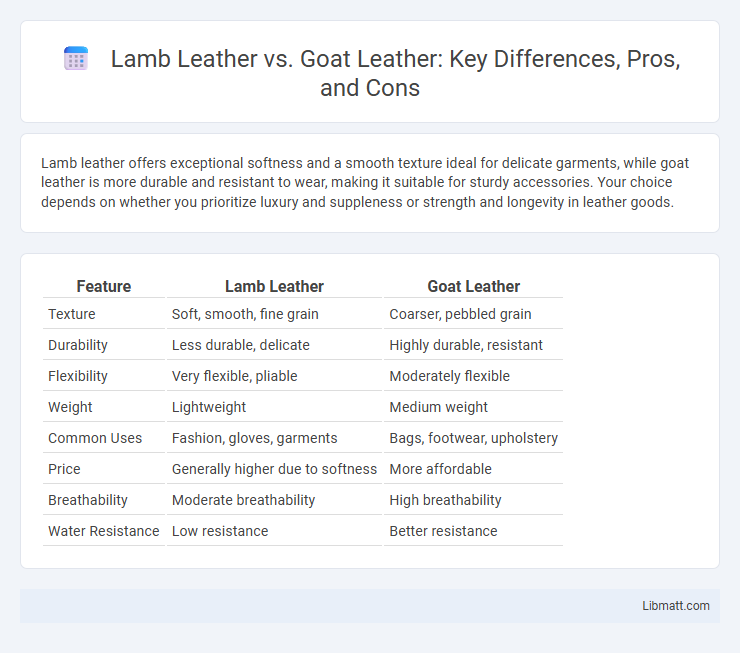Lamb leather offers exceptional softness and a smooth texture ideal for delicate garments, while goat leather is more durable and resistant to wear, making it suitable for sturdy accessories. Your choice depends on whether you prioritize luxury and suppleness or strength and longevity in leather goods.
Table of Comparison
| Feature | Lamb Leather | Goat Leather |
|---|---|---|
| Texture | Soft, smooth, fine grain | Coarser, pebbled grain |
| Durability | Less durable, delicate | Highly durable, resistant |
| Flexibility | Very flexible, pliable | Moderately flexible |
| Weight | Lightweight | Medium weight |
| Common Uses | Fashion, gloves, garments | Bags, footwear, upholstery |
| Price | Generally higher due to softness | More affordable |
| Breathability | Moderate breathability | High breathability |
| Water Resistance | Low resistance | Better resistance |
Introduction to Lamb Leather vs Goat Leather
Lamb leather is prized for its softness, fine grain, and lightweight feel, making it ideal for high-end fashion and delicate garments. Goat leather, by contrast, offers greater durability and a more pronounced texture, suitable for rugged accessories like bags and shoes. Your choice between lamb and goat leather depends on whether you prioritize suppleness and luxury or toughness and resilience.
Origin and Source of Lamb and Goat Leather
Lamb leather originates from the skins of young sheep typically under one year old, predominantly sourced from regions with extensive sheep farming such as New Zealand, Australia, and parts of Europe. Goat leather is derived from mature goats, with major suppliers including countries like India, Pakistan, and Nigeria, known for their large goat populations and established leather industries. The age and breed of the animal directly influence the texture and durability of the leather, making lamb leather softer and more supple, while goat leather is generally more durable and grainy.
Texture and Appearance Comparison
Lamb leather features a smooth, soft texture with a fine grain that offers a luxurious, supple feel ideal for high-end fashion. Goat leather presents a more pronounced grain pattern and a slightly firmer texture, combining durability with a distinct natural appearance. Your choice depends on whether you prefer the delicate, refined aesthetic of lamb leather or the resilient, textured look characteristic of goat leather.
Durability and Strength Differences
Lamb leather is prized for its softness and fine grain but tends to be less durable and more prone to wear compared to goat leather. Goat leather is known for its superior strength and resistance to abrasion, making it ideal for products that require longevity and toughness. When choosing leather for your items, understanding these durability and strength differences ensures you select the best material for your needs.
Softness and Flexibility: Which is Better?
Lamb leather is renowned for its exceptional softness and supple texture, making it highly flexible and ideal for garments that require gentle comfort. Goat leather, while also soft, offers a slightly firmer feel with greater durability and natural grain, which provides a balance between flexibility and toughness. Your choice depends on whether you prioritize the ultra-soft, pliable nature of lamb leather or the resilient, flexible qualities of goat leather.
Weight and Thickness Analysis
Lamb leather typically weighs between 1.2 to 1.5 ounces per square foot and is thinner, often ranging from 0.5 to 0.7 millimeters in thickness, making it lightweight and flexible. Goat leather tends to be heavier, averaging 1.6 to 2.0 ounces per square foot, with a thickness of about 0.8 to 1.0 millimeter, which provides greater durability and resistance. The difference in weight and thickness influences their application, with lamb leather favored for soft, delicate products and goat leather preferred for sturdier, more resilient items.
Common Uses in Fashion and Accessories
Lamb leather is prized in fashion for its soft texture and fine grain, making it ideal for luxury garments, high-end gloves, and delicate handbags. Goat leather, known for its durability and natural grain, is commonly used in rugged accessories such as sturdy boots, wallets, and belts. Both types offer unique qualities that cater to different design aesthetics and functional demands in the fashion industry.
Price and Market Value Comparison
Lamb leather typically commands higher prices due to its softness, fine grain, and limited supply, making it a premium choice in luxury goods markets. Goat leather, known for its durability and distinctive texture, is generally more affordable and widely available, offering strong market value in durable goods sectors. Your decision between lamb and goat leather should consider budget constraints and the intended quality or longevity of the product.
Care and Maintenance Requirements
Lamb leather requires gentle cleaning with mild soap and water to maintain its soft texture, avoiding excessive moisture which can cause damage. Goat leather is more durable and water-resistant, allowing for easier maintenance with regular conditioning to prevent drying and cracking. Both types benefit from storage in a cool, dry place away from direct sunlight to preserve longevity.
Choosing the Right Leather: Lamb or Goat?
Lamb leather offers a soft, smooth texture and delicate grain, making it ideal for luxury apparel and accessories requiring a supple finish. Goat leather is more durable and has a coarser grain, suitable for products needing strength and resistance, such as boots and bags. Selecting between lamb and goat leather depends on the desired balance of softness versus durability for the intended use.
Lamb leather vs goat leather Infographic

 libmatt.com
libmatt.com